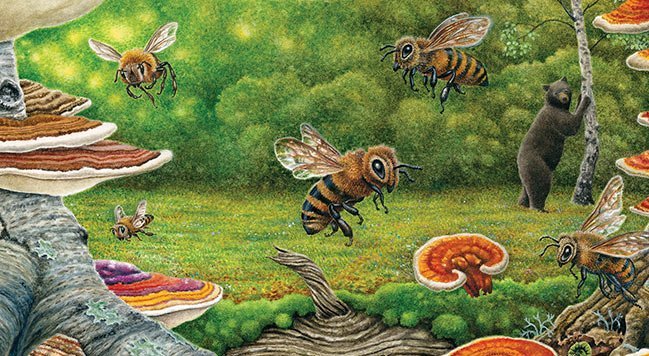This peppermint white chocolate creamer is the perfect way to enjoy your favourite holiday coffee…
In 2015, Colony Collapse Disorder (CCD) rates increased 6% to affect 41% of managed bee colonies nationwide. Some scientists estimate that all managed bee colonies could face total decimation by CCD within five years.
“Our research goal is to help solve Colony Collapse Disorder. And the results look promising.”
Although CCD is not fully understood, it appears to be a destructive synergism of multiple factors. Pathogen (bacterial and viral) infections harm bees already challenged by other stress factors, including parasitic mites, pesticides, fungicides and GMO exposure. These stressors of infection, parasitism, toxins, and immune deficits/depression may initiate CCD.
Helping to save the honeybee with mushrooms
 In 2014, Paul Stamets (leading mycologist, visionary and TED Talk presenter), Steve Sheppard (chair of department of entomology, Washington State University) and the Washington State Beekeepers Association teamed up in a research initiative called BeeFriendly to help reverse devastating declines in the global bee population that are critically threatening the world’s food security.
In 2014, Paul Stamets (leading mycologist, visionary and TED Talk presenter), Steve Sheppard (chair of department of entomology, Washington State University) and the Washington State Beekeepers Association teamed up in a research initiative called BeeFriendly to help reverse devastating declines in the global bee population that are critically threatening the world’s food security.
Last year, 300 sets of bees consumed Host Defense mushroom extracts via their feed water. The experiments were designed to measure how mushroom extract supplementation impacted viral burdens and longevity.
Host Defense extracts, especially Reishi and Chaga, showed substantial benefit to honeybees, including extended longevity and reduction of their viral burden by more than 75%.
Promising results
“Our research goal is to help solve Colony Collapse Disorder. And the results look promising, with regard to the Host Defense Chaga and Reishi extracts,” Sheppard says. “As an entomologist with 39 years of experience studying bees, I am unaware of any reports of materials that extend the life of worker bees more than this.”
Dozens more experiments are underway including research on whether certain species of mycopesticide fungi can eliminate the parasitic Varroa destructor mites that decimate beehives around the world.
“We take bees from colonies with high Varroa mite levels and set up numerous test environments with fungi,” says Sheppard. “We’re finding that the fungi product is killing mites without harming bees. It’s certainly encouraging.”


